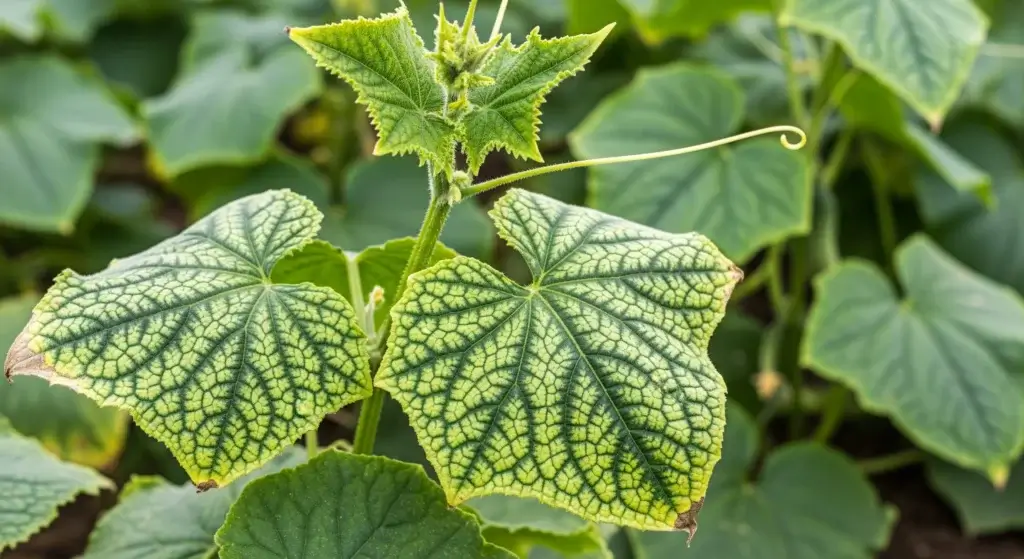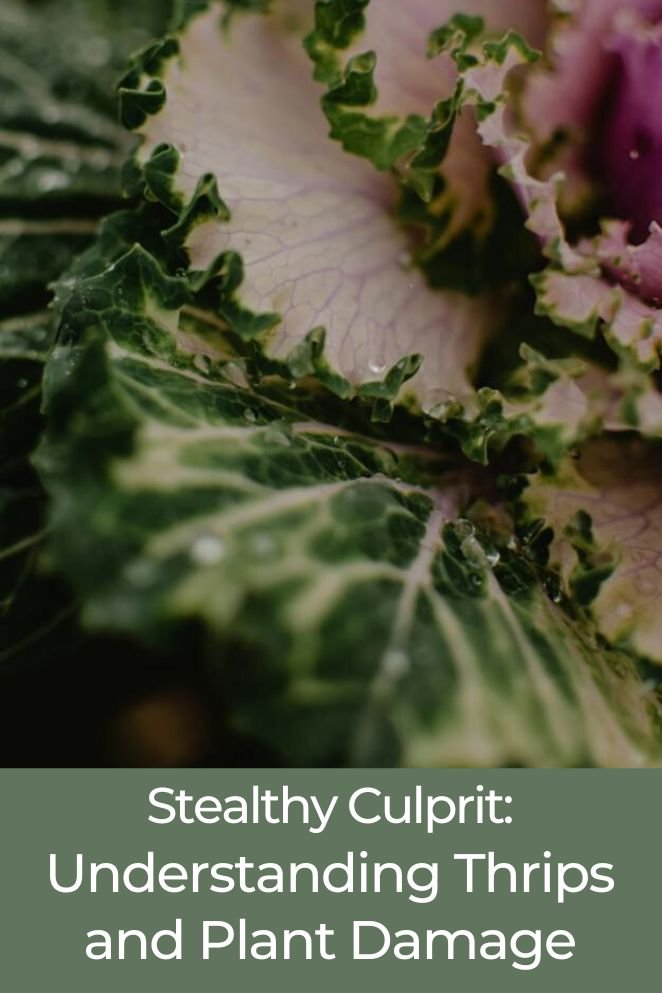
Gardening is such a delightful hobby, but it’s not without its challenges.
One pesky little insect that can really throw a wrench into your gardening bliss is the thrips.
In this guide, let’s explore the world of thrips plant damage, taking a close look at their physical traits and exploring practical ways to keep them in check.
What are Thrips?
Thrips, tiny and often unnoticed, can harm plants with their slender bodies measuring 1 to 2 millimeters.
Their unique lace-like wings aid in swift movements, while asymmetrical mouthparts act like built-in straws, piercing and sucking plant juices deceptively.
Thrips’ color variations, from yellow to brown or black, serve as effective camouflage in the garden.
Recognizing these features is vital for early detection and protection against potential plant damage.
- Read also: Natural Pesticides for Vegetable Garden
- Read also: How To Make a Natural Pesticide
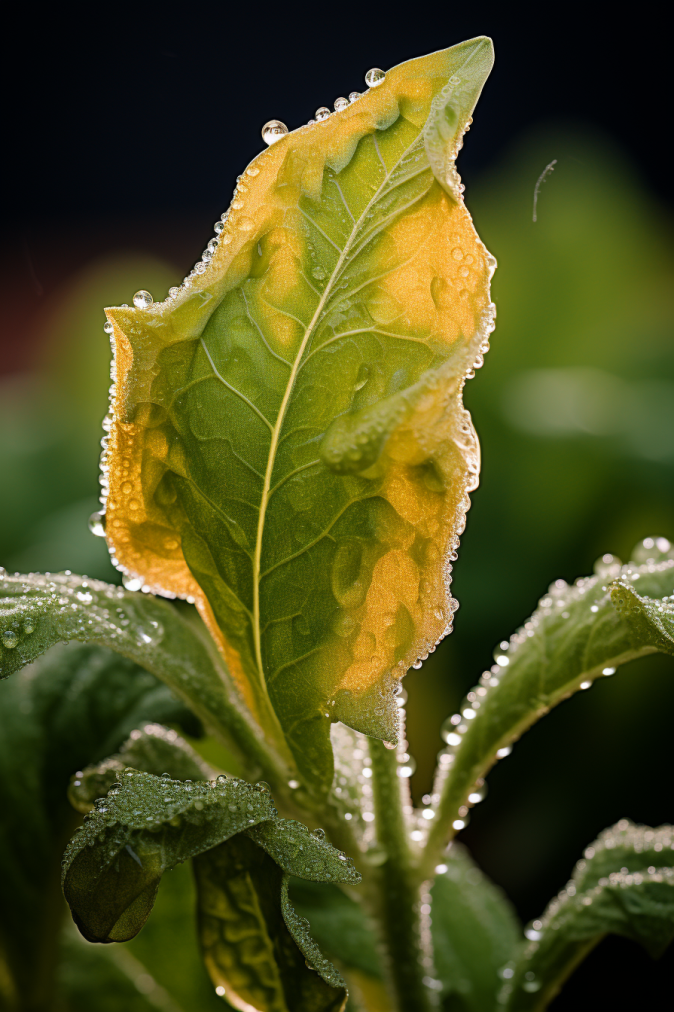
Common Thrips Species Affecting Plants
Your garden may be a haven for growth, but it’s also a potential battleground against various thrips species.
Meet some of the most troublesome thrips with a penchant for plants that you might come across:
Western flower thrips (Frankliniella occidentalis)
These thrips are notorious for their light coloration, ranging from yellow to light brown.
Their wings boast a distinctive dark band, setting them apart.
Western Flower Thrips have a voracious appetite for a wide variety of plants, causing damage by feeding on flowers, leaves, and even fruits.
Onion thrips (Thrips tabaci)
Smaller in size compared to their counterparts, onion thrips have a yellow to brownish color.
Their wings are fringed, aiding in their swift movements.
As the name suggests, onion thrips often target crops like onions, leeks, and garlic. Their feeding can lead to stunted growth and reduced yields.
Tobacco thrips (Frankliniella fusca)
These thrips are slender and vary in color from yellow to dark brown.
Their wings may exhibit a distinctive dark pattern. Tobacco thrips pose a threat to a wide range of crops, including peanuts and soybeans.
Their feeding can result in distorted plant growth and reduced crop quality.
Rose thrips (Thrips fuscipennis)
Recognizable by their dark brown to black coloration, rose thrips are relatively small in size.
Their wings may have a characteristic dark stripe. Roses and other ornamental plants are prime targets for rose thrips.
They can cause discoloration, deformities, and reduced flower quality.
Bean thrips (Caliothrips fasciatus):
Bean thrips are small and usually yellowish-brown.
Their bodies may have a distinctive pattern, and their wings are fringed.
Beans and other legumes are particularly susceptible to bean thrips. Infestations can result in leaf stippling, distortion, and reduced yields.
Citrus thrips (Scirtothrips citri)
Specializing in citrus mischief, these thrips earn their title by making citrus fruits their primary feast.
They leave a mark on the rinds, creating unsightly brown, corky lesions that can affect the overall marketability of the fruits.
These floral fanatics also have a taste for citrus flowers, impacting the fruit set and ultimately affecting the yield of the citrus trees.
These thrips can also inflict damage on other fruits, vegetables, and ornamental plants.
Their voracious appetite knows no bounds, making them a potential menace to various elements of your garden or orchard.
Banded palm thrips (Parthenothrips dracaenae)
This thrip is an unwelcome guest, thriving in greenhouses and household spaces, particularly targeting popular houseplants such as dracaenas, palms, and ficus.
Known as the speckled scourge, its feeding habits can be identified by the brown or black speckles it leaves on the leaves of plants.
This unwelcome decoration is often accompanied by distorted foliage and stunted growth.
What sets this thrip apart is its year-round residency.
Unlike many of its counterparts, it doesn’t take a seasonal break.
Instead, it lives and breeds persistently throughout the year, making it a constant and unwavering pest in indoor environments.
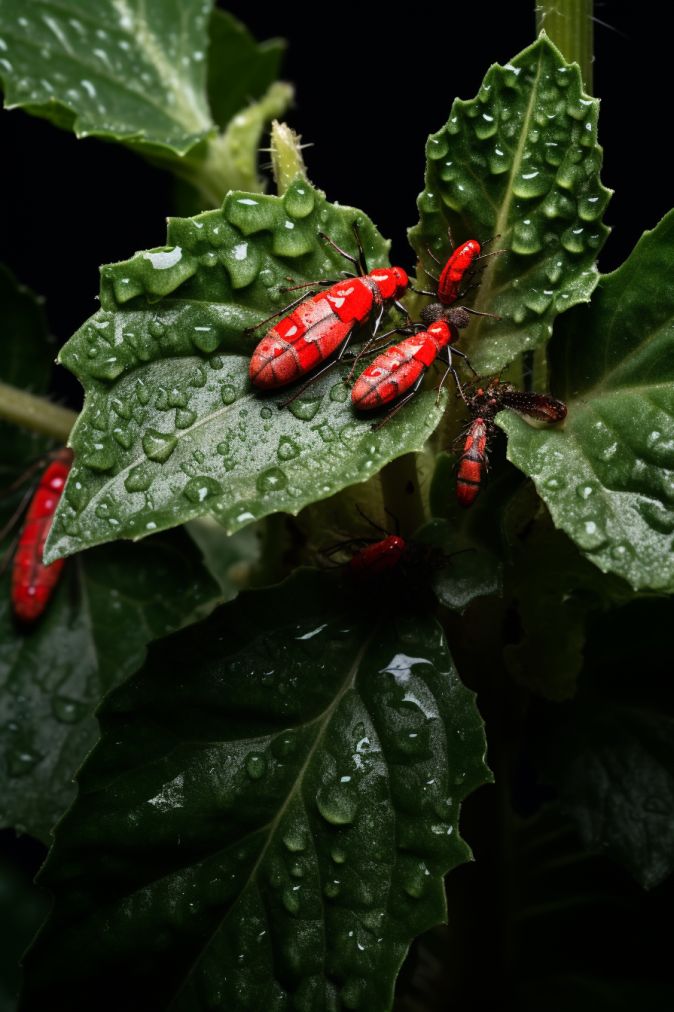
Life Cycle of Thrips and The Stage for Intervention
Having a grasp of this life cycle is essential for implementing timely interventions to curb their impact on crops and ornamental plants.
Let’s delve into the details of each stage:
Stage 1: Egg
The life cycle of thrips commences with the laying of eggs.
Female thrips insert eggs into plant tissues like leaves, petals, and stems.
Eggs are typically laid within the leaf tissue, where they find protection and a suitable environment for development.
Stage 2: Larva
First-instar
Thrips hatch into wingless and mobile nymphs. These hatchlings exhibit an elongated form and present themselves in shades of white or yellow.
Their feeding mechanism involves piercing the plant cells and extracting the nutrient-rich contents.
This feeding behavior begins immediately after hatching, signifying the swift impact thrips can have on host plants.
Within a few days, thrips undergo a molt. It marks a notable transition in their appearance and physiology.
Second-instar larva
At this stage, they become slightly larger and sturdier compared to their earlier instar.
Some pigmentation may also develop, contributing to their changing appearance.
Continuing to extract nutrients from plant tissues, this sustained feeding activity can result in various forms of damage, including scarring, silvering, or deformations on the affected plant.
Thrips in this stage actively prepare for pupation.
They seek out a suitable location on the host plant or in the surrounding soil to undergo this transformative process.
Stage 3: Pupa
Pupation occurs in the soil or within plant tissues.
Pupae are relatively inactive, completely immobile, and do not feed, undergoing internal changes as they transform into the adult form.
The pupal stage is a crucial period for potential control measures, as thrips are relatively vulnerable during this phase.
Stage 4: Adult
Adult thrips have slender bodies, fringed wings, and distinctive mouthparts adapted for piercing and sucking.
Adults are responsible for further feeding and reproduction, perpetuating the cycle.
Thrips can be highly mobile during the adult stage, facilitating their spread to new host plants.
How to Recognize Thrips Damage
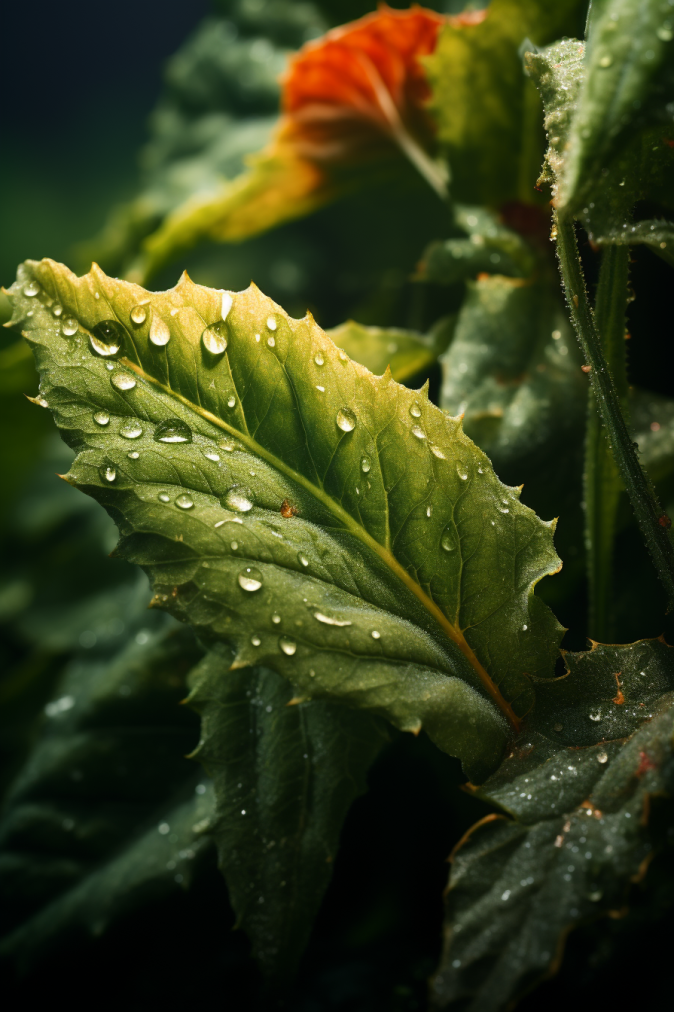
Damage on the leave
Stippling
Look for tiny, silvery, or discolored flecks on the leaves, resembling marks as if someone poked them with a needle.
Stippling is an early sign of thrips feeding, indicating their presence and potential impact on plant health.
Streaking
Observe brown or yellow streaks on leaves, especially concentrated near veins.
Streaking suggests localized damage caused by thrips feeding along veins, affecting the overall appearance of the foliage.
Distortion
Note curled, twisted, or stunted leaves, particularly evident in new growth.
Distorted leaves indicate the influence of thrips on the normal development of plant tissues, affecting both aesthetics and functionality.
Silvering
Recognize a reflective sheen on the leaf surface, resulting from air pockets created by thrips feeding.
Silvering is a distinctive visual cue, signaling advanced thrips activity and potential damage to the plant’s photosynthetic processes.
Dropping
Watch for premature leaf drop, especially in severe thrips infestations.
Dropping leaves can be a consequence of significant stress caused by sustained thrips feeding, impacting the overall vitality of the plant.
Damage to the flower
Deformed or discolored petals
Thrips feeding can result in distorted and discolored flower petals, exhibiting misshapen or stained characteristics.
This visual alteration indicates the direct impact of thrips on the aesthetic appeal and quality of the blooms.
Bud damage
Thrips may target developing flower buds, leading to consequences such as premature dropping or improper opening.
Bud damage interferes with the normal flowering process, affecting the overall abundance and vitality of the plant’s blooms.
Reduced pollination
Thrips feeding on pollen can disrupt the pollination process, potentially reducing the success of fruit and seed sets.
The interference with pollination by thrips can have cascading effects on the reproductive success of plants, impacting future generations.
Damage to the stem
Scarred surfaces
Thrips feeding involves piercing and extracting plant cell contents.
This activity can result in visible scars on the surfaces of stems, compromising their structural integrity and aesthetic appearance.
Stunted growth
Prolonged thrips infestations can lead to stunted growth of stems.
The continuous feeding on plant tissues hampers the normal development of stems, hindering their ability to elongate and contribute to overall plant stature.
Distorted form
Thrips feeding on stem tissues may cause distortions in their form.
This can manifest as twisted or contorted stems, altering the natural growth pattern and impacting the plant’s structural balance.
Reduced vigor
Weakened stems due to thrips damage can result in reduced plant vigor.
Stems play a crucial role in transporting water, nutrients, and sugars throughout the plant.
Any compromise in stem health can affect these essential processes, leading to diminished overall plant vitality.
Entry points for diseases
Thrips feeding creates wounds on stem surfaces, providing potential entry points for pathogens.
These wounds can serve as openings for various diseases, further jeopardizing the health of the plant.
Drooping or wilting
Severe thrips infestations may lead to the wilting or drooping of stems.
This is a visible sign of stress and damage, as thrips feeding disrupts the normal functioning of vascular tissues responsible for water transport.
Damage to the fruit
Surface scarring
Thrips feeding on fruit surfaces can result in visible scarring.
These scars may appear as tiny punctures or blemishes on the fruit’s skin, affecting its marketability and aesthetic appeal.
Deformities
Thrips infestations can lead to the development of deformed fruits.
This can include irregular shapes, abnormal growth patterns, or misshapen fruit, reducing their commercial value and consumer desirability.
Staining
Thrips feeding may cause staining on the fruit’s surface.
This can manifest as discoloration or dark spots, diminishing the visual quality of the fruit.
Premature ripening
Thrips damage can accelerate the ripening process of fruits, leading to premature ripening.
This can result in fruits that are softer, more perishable, and prone to decay, impacting their shelf life.
Internal damage
Thrips may also cause internal damage to fruits by feeding on the flesh.
This can lead to the formation of corky tissues, affecting the fruit’s texture and edibility.
Russeting
Thrips feeding on fruit surfaces can harm the protective waxy coating, resulting in a textured surface known as russeting.
Russeting impairs the fruit’s visual appeal, creating a rough texture that may affect marketability and diminish overall fruit quality.
Blossom-end rot
Thrips damage can create entry points for fungal pathogens, particularly leading to issues like blossom-end rot.
Blossom-end rot can cause rapid spoilage and decay, significantly impacting the fruit’s integrity and edibility.
Methods for Thrips Elimination: What Are They?
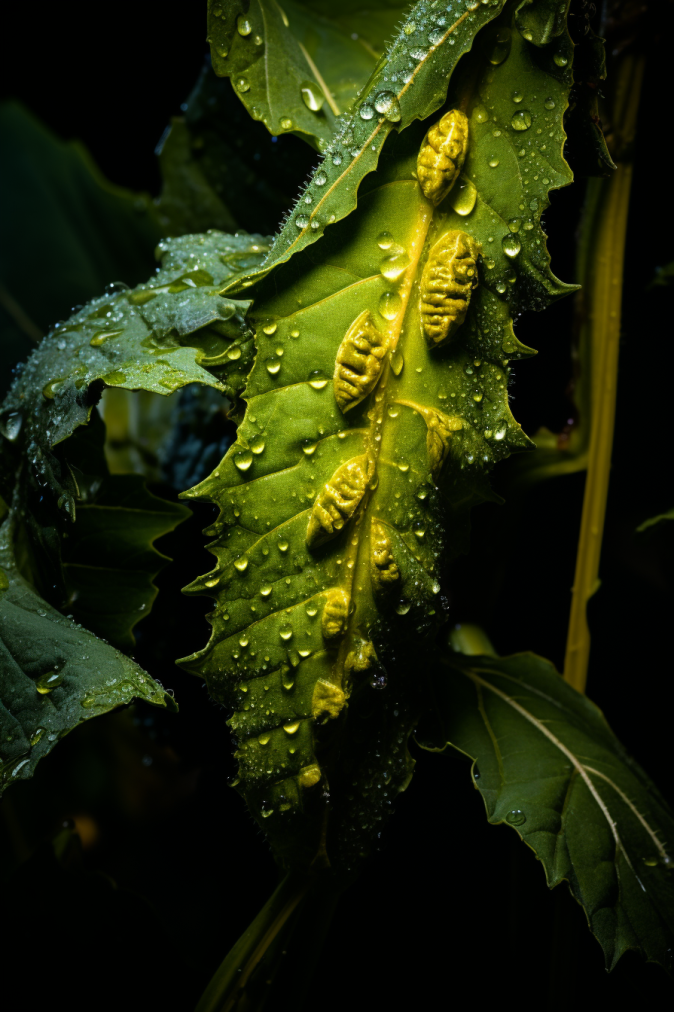
Biological control methods
Beneficial insect
Encouraging the presence of beneficial insects in your garden is an effective and natural way to manage thrip populations.
Ladybugs, lacewings, predatory mites, and minute pirate bugs are among the allies you can attract.
Beneficial nematodes
Beneficial nematodes are microscopic organisms that parasitize and kill thrips larvae in the soil.
Organic control methods
Insecticidal soap
Formulated from natural oils and fats, this solution works by disrupting the cell membranes of thrips upon contact, resulting in their elimination.
Neem oil
Neem oil serves as both a natural insecticide and a repellent, it disrupts thrips’ feeding and reproductive abilities.
Garlic or onion-based sprays
Create organic sprays using garlic or onion extracts.
These solutions act as natural repellents, making the environment less favorable for thrips.
Mechanical control methods
Sticky traps
Deploying sticky traps strategically near affected plants can help manage adult thrips effectively.
Opt for either blue or yellow sticky cards to attract and trap thrips, thus reducing their population.
Handpicking
For smaller thrip infestations, consider handpicking as an efficient method.
Remove thrips manually, paying special attention to affected flowers and buds.
This approach can be particularly useful in controlling localized outbreaks.
Water blast
Employ a strong spray of water to dislodge thrips from leaves and flowers.
This technique is especially effective for dealing with soft-bodied thrips.
Chemical control methods
Contact insecticides
Consider using contact insecticides for immediate control of thrips.
These solutions act upon direct contact with thrips, effectively eliminating them.
Noteworthy options in this category include insecticidal soap, pyrethrins, and spinosad.
However, it’s important to note that contact insecticides only affect the areas where they are sprayed.
Systemic insecticides
Systemic insecticides offer longer-lasting protection by being absorbed by the plant and distributed throughout its tissues.
Examples of systemic insecticides include imidacloprid, dinotefuran, and thiamethoxam.
These options provide a more comprehensive approach to thrip control, as the entire plant becomes fortified against infestations.
- Read also: Natural Pest Control Methods for Your Vegetable Garden
- Read also: Flowers for Vegetable Garden Pest Control
Conclusion
The initial key to ensuring a flourishing garden is grasping the impact of thrips on your plants.
By familiarizing yourself with these pests, understanding the indications of damage, and employing successful control methods, you not only shield your plants but also uphold the aesthetic appeal of your outdoor space.
This knowledge equips you to take proactive measures to maintain a healthy and vibrant garden environment.
Frequently Ask Questions
Thrips have the potential to infest a broad spectrum of plants, ranging from vegetables to ornamentals. It is crucial to maintain regular monitoring to detect and address infestations at an early stage.
Absolutely! There are effective alternatives such as biological control methods and organic methods that significantly reduce the reliance on chemical interventions.
It is advisable to conduct regular inspections, ideally at least once a week, especially during the growing season. Early detection is key as it enables swift and targeted action against potential thrip infestations.

